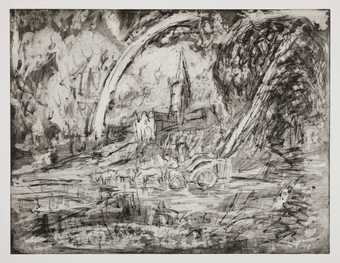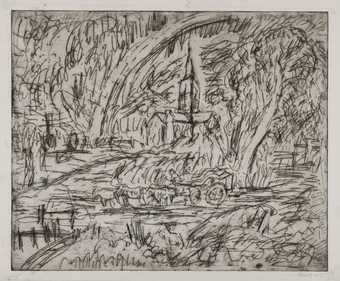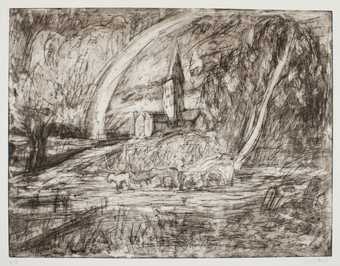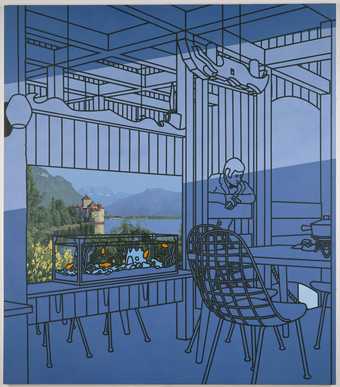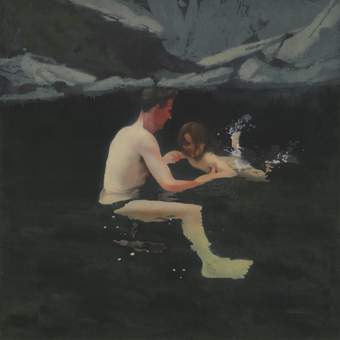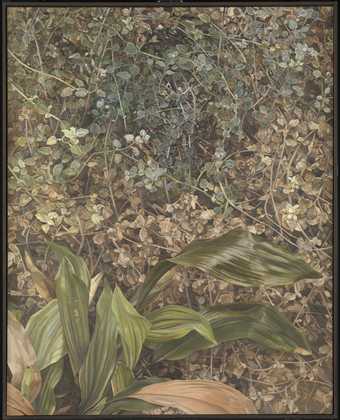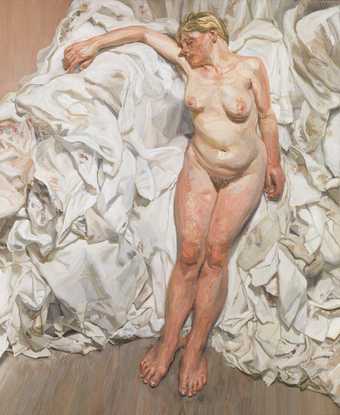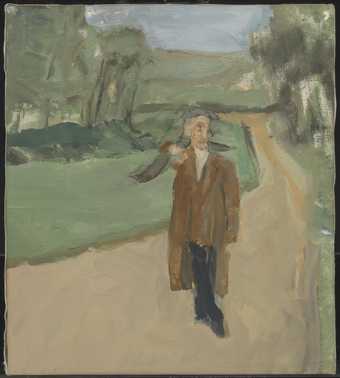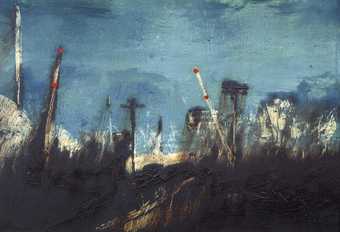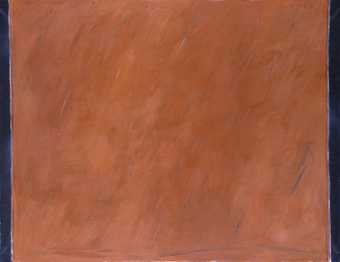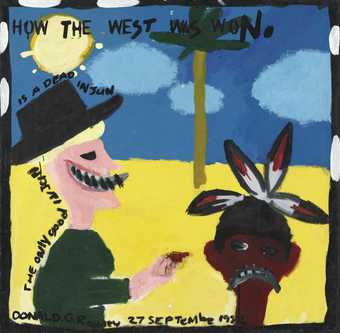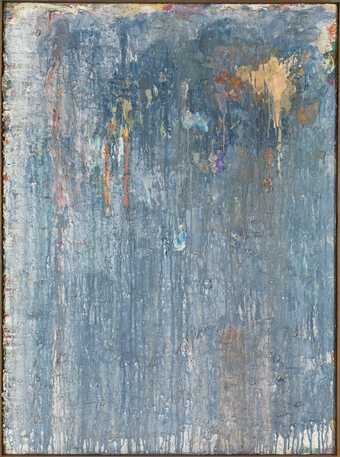
Not on display
- Artist
- Michael Andrews 1928–1995
- Medium
- Acrylic paint on canvas
- Dimensions
- Support: 2439 × 2743 mm
- Collection
- Tate
- Acquisition
- Purchased with assistance from the Friends of the Tate Gallery 1993
- Reference
- T06677
Summary
Michael Andrews first visited Uluru or Ayers Rock, Australia in October 1983. The result of his visit to the Rock and the surrounding area was a number of watercolour sketches made on site and nine large pictures painted in his studio in Norfolk, England between 1984 and 1990.
Prior to his visit Andrews was aware of the sacred significance of the Rock within the animist tradition of indigenous Australians. According to local belief all things in the world were created during the 'time before time' known as the Dreamtime. During the Dreamtime the ancestor spirits, who came to Earth as humans and other forms, shaped the land, plants and animals as we know them today. At the end of the Dreamtime the spirits changed again, into animals, stars, hills and other objects. Uluru, as the Rock is known by the local Ananga people, is the form assumed by one such ancestor at the end of the Dreamtime, and as such the ancestor is immanent in it. Andrews was struck by a parallel between Uluru as the physical manifestation of a deity and the Christian hymn which metaphorically presents God as 'The Rock of Ages, cleft for me'. Indeed, when Laughter Uluru (Ayers Rock), The Cathedral I was first exhibited along with other works from this series it was in an exhibition at the Anthony d'Offay Gallery in 1986 entitled Rock of Ages Cleft for Me: Recent Paintings by Michael Andrews.
The title of the painting refers partly to the name of the large vermilion cave in the centre of the picture which the Ananga call 'Lagari' (Laughter), and partly from Andrews' sense of Uluru as similar to a cathedral in its grandeur and religious significance. It is a comparison, which has led the critic William Feaver to liken the Rock to Chartres cathedral seen rising out of the countryside.
Andrews began the long process of painting by projecting a slide reproduction of one of his watercolour sketches onto the unmarked canvas. He found this practice to be useful because 'as often as not the circumstantial marks in a drawing will turn out to have a structural significance in the picture' (quoted in Feaver, p.10). Having established the basic structure he deployed a great variety of tones and textures to articulate the painting's surface. In the foreground the bush has been painted by spraying tan coloured acrylic paint over stencils made from the same coarse grass that grows in the sandy soil around the Rock. Visible in the haze of paint are actual blades of grass and seeds. The gullies of the Rock are punctuated by passages of scraped impasto paint mixed with red sand taken from the site by Andrews. In contrast to the granular surface of the gullies, the soft lipped cave was achieved by staining the canvas surface with thinned paint. These textural variations are complemented by the subtle tonal variations evident throughout the painting. The pulsating rhythm created by this use of texture and tone combine with the large size of the canvas to generate a sense of a living and overwhelming phenomenon.
Further reading:
William Feaver, Rock of Ages Cleft for Me: Recent Paintings by Michael Andrews, exhibition catalogue, Anthony d'Offay Gallery, London 1986, p.7, reproduced p.7, cat.no.1 (colour)
Michael Andrews 'The Delectable Mountain': The Ayers Rock Series and other Landscape Paintings, exhibition catalogue, Whitechapel Art Gallery, London 1991, reproduced p.29 (colour)
Toby Treves
October 2000
Does this text contain inaccurate information or language that you feel we should improve or change? We would like to hear from you.
Display caption
Andrews made this work following a ten-day stay at Ayers Rock - known as Uluru to the Aborigines - in the desert of Australia's Northern Territory. The rock embodies many of the problems and contradictions of modern tourism. At 348m (1,143 feet) high, it is the world's largest monolith and a major destination for tourists. Historically, however, it is a sacred site for several Aboriginal tribes and its caves contain carvings and paintings. To evoke the site's spiritual dimension Andrews has adopted the anthropomorphic convention of suggesting human forms in the land by accentuating the mouth-like characteristics of a gash in the mountainside.
Gallery label, August 2004
Does this text contain inaccurate information or language that you feel we should improve or change? We would like to hear from you.
Technique and condition
The following entry is based on an interview with the artist held on 8 June 1993.
The painting is one of a series begun in 1984 and painted in the artist's studios in Norfolk from studies made in Australia.
Andrews drew the sizes he required for his canvases in charcoal on the white walls of his studio. From these drawings he had the stretchers made up. The stretcher for 'Uluru' divides vertically down the centre so that the painting could be folded around a central roller allowing it to pass through a window in his studio. The untreated cotton duck canvas was stretched onto the stretchers in the studio and received no preparation or priming before painting. Nine of the Australian series were prepared at this time.
A preliminary drawing was done in charcoal from watercolours and photographs made at Ayers Rock in October 1983.
The painting was carried out over several months and is done predominantly in Aqua-tec artists' acrylic paints, thinned only with water and applied in a variety of ways including spraying. Included into the thin layers of paint are rock dust from Ayers Rock and dry artists' pigments. These were strewn onto wet areas of unpigmented acrylic medium and sprayed over with thinned acrylic paint. The small white specks visible in some dark areas are where these granular inclusions have been rubbed off.
To control his spray applications Andrews used masks cut out of card and pinned to the canvas. In the foreground he also made use of grass as masks, some of which remains trapped in the paint.
The painting is not varnished and on acquisition the only treatment required was the insertion of a protective fabric lining between the back of the canvas and the stretcher, reinforcement of the divided stretcher bars and replacement of the thin batten frame with one of the same appearance as that the artists had fitted.
Explore
- countries and continents(17,390)
-
- Australia(72)
- Ayers Rock(1)
- mysticism(2,612)
-
- spirituality(739)
You might like
-
Leon Kossoff Salisbury Cathedral from the Meadows (1)
1998 -
Leon Kossoff Salisbury Cathedral from the Meadows (2)
1998 -
Leon Kossoff From Constable: Salisbury Cathedral from the Meadows (plate 1)
1996–7 -
Leon Kossoff From Constable: Salisbury Cathedral from the Meadows (plate 2)
1996–7 -
Michael Andrews The Deer Park
1962 -
Patrick Caulfield After Lunch
1975 -
Michael Andrews Melanie and Me Swimming
1978–9 -
Lucian Freud Two Plants
1977–80 -
Lucian Freud Standing by the Rags
1988–9 -
Michael Andrews Study for a Man in a Landscape (Digswell)
1959 -
Colin Self The Crossing
1985 -
Michael Finn Red Painting
c.1989 -
Donald Rodney How the West was Won
1982 -
Gillian Ayres RA CBE Weddell
c.1973–4 -
Winston Branch Zachary II
1982

